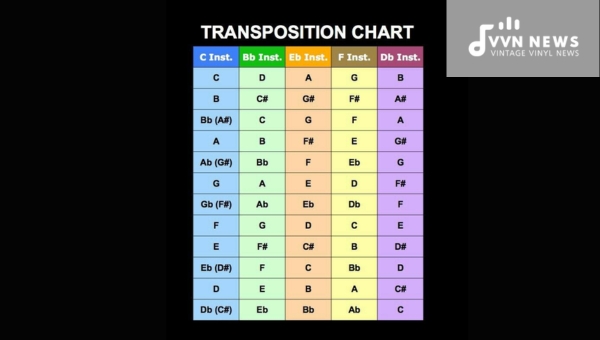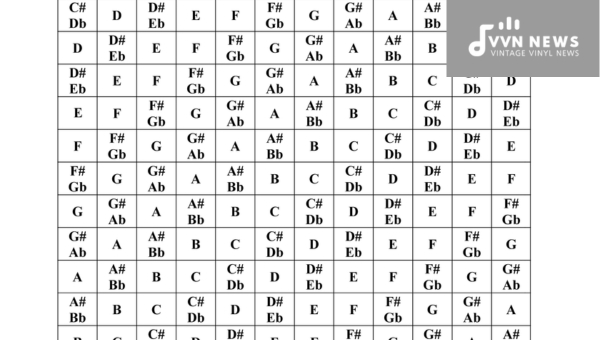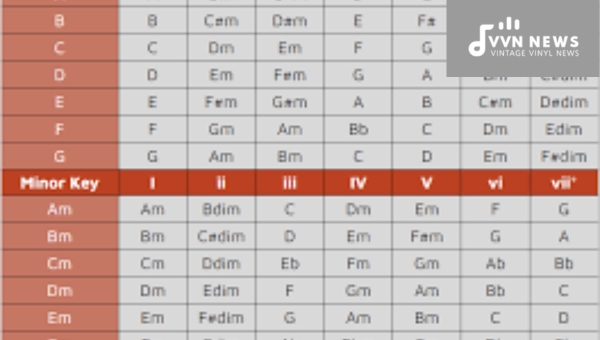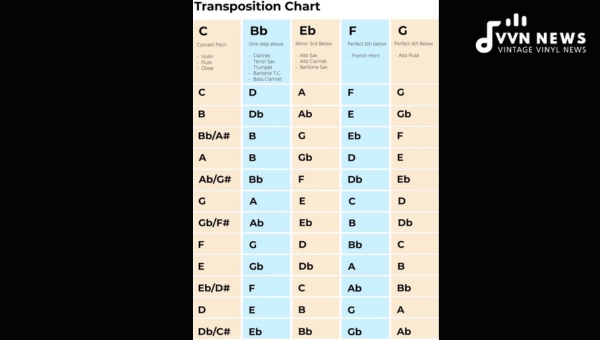Navigating the often complex world of music theory can seem like a daunting task, filled with a plethora of confounding terms.
Among these, one that often confuses beginners and professionals alike is the transposition chart.
These charts, a critical aspect in the realm of music theory, provide significant value to those learning or already proficient in playing instruments.
A transposition chart is essentially a key to deciphering sounds and melodies. It serves as a guide to shift notes and essentially ‘transpose’ them into different keys.
Though it may seem intimidating at first glance, fear not! In our exploration today, I’ll guide you through the process of reading and using a transposition chart effectively and efficiently.
What Is a Transposition Chart?

A transposition chart is a valuable tool for musicians that helps facilitate the process of transposing music from one key to another.
It provides a visual representation of how each note in the original key corresponds to its new position in the transposed key.
This allows musicians to easily convert sheet music from one key to another without having to manually calculate the new positions of each note.
A transposition chart typically consists of two columns: one for the original key and one for the transposed key.
The rows usually contain each note of the musical alphabet, including sharps and flats. By referring to the chart, musicians can quickly identify which pitch corresponds with each note in different keys.
Transposing music can be necessary for a variety of reasons. For example, if a singer finds that a particular song sits too low or too high for their vocal range, they may need to transpose it to a higher or lower key respectively.
If you are playing with other musicians who are in a different key, you will need to transpose your part so that it aligns harmonically.
A transposition chart is an indispensable tool for musicians who want to expand their repertoire and adapt music to their own playing range or ensemble requirements.
It simplifies the process and allows them to focus on expressing themselves through their instrument rather than getting bogged down by technicalities.
Why Do Musicians Need a Transposition Chart?
Transposing music is a skill that is essential for many musicians. It allows them to adapt pieces of music to suit their instrument or vocal range, play with other musicians in different keys, or create unique arrangements.
Transposing can be complex and time-consuming, especially for those who are not well-versed in music theory. This is where a transposition chart becomes an invaluable tool.
- Efficiency and Accuracy: A transposition chart provides a quick and accurate reference for transposing music. Instead of manually calculating the pitch changes for each note, musicians can simply consult the chart and follow the corresponding positions in the new key. This saves time and minimizes errors.
- Simplicity: Using a transposition chart reduces the complexity of transposing music. Rather than grappling with intervals or chord progressions, musicians can rely on the visual representation of the chart to guide them through the process. It simplifies the task and allows them to focus on playing or singing without being burdened by intricate technicalities.
- Versatility: A transposition chart caters to musicians across various instruments. Whether you play piano, guitar, trumpet, saxophone, or any other instrument with different pitch ranges, a transposition chart can be customized to accommodate your specific needs. It ensures that you can confidently navigate between keys and expand your musical repertoire.
- Collaboration: When playing in ensembles or bands, it’s common for each musician to be in a different key (for example, B♭ trumpet versus concert pitch). In such scenarios, having access to a reliable transposition chart allows everyone to transpose their parts accurately so that they harmonize seamlessly together.
- Key Changes: Some songs may sound better or suit your voice/instrument more effectively if played in a different key. With a transposition chart on hand, you can easily change the key of the piece, making it more comfortable to perform and enhancing its overall musicality.
- Teaching and Learning: Transposition charts are excellent teaching aids, especially for music teachers working with students who are just starting to explore transposing. The chart helps simplify the process and allows students to grasp the concept more easily.
A transposition chart is a valuable tool that empowers musicians to transpose music efficiently and accurately. Its simplicity, versatility, and usefulness in collaborative settings make it an essential resource for musicians of all levels.
By utilizing a transposition chart, musicians can confidently explore new keys, adapt music to their preferences or ensemble requirements, and expand their repertoire with ease.
Also Read: Circle Of Fifths Seventh Chords [How To Navigate The Chart]
How Do You Use a Transposition Chart Effectively?

Using a transposition chart effectively requires some basic practice. Here are some steps to help you make the most of this valuable tool:
- Familiarize yourself with the layout: Take a moment to study the structure of the transposition chart. Note that the left column represents the original key, while the right column indicates the transposed key.
- Determine your original and desired keys: Identify the key of the piece you want to transpose and decide on your desired key. For example, if your original key is C major and you want to transpose it to F major, make a mental note of these keys.
- Locate the original note: Find the note in the left column that corresponds with the pitch you want to transpose from your original key. For instance, if you’re looking for C in C major, find it in the left column.
- Follow it across: Once you’ve located your starting note, follow it across horizontally until you reach the transposed key column. This will give you a new note for your desired key.
- Apply accidentals: If there are accidentals (sharps or flats) in your original key, be sure to apply them to your new notes as well. This ensures that you maintain the correct pitch relationships between notes.
- Continue for other notes: Repeat steps 3-5 for each additional note in your piece that needs transposing. By referring back and forth between columns, you can quickly find the corresponding notes for your new key.
- Verify and practice: Once you have finished transposing all necessary notes, double-check your work by playing through or comparing it with a recording in your desired key. Use this opportunity to practice playing in this new key as well.
Remember that using a transposition chart effectively takes time and practice, especially if you’re just starting with transposing music.
As you become more familiar with the process, you’ll naturally develop a quicker and more accurate understanding of how to navigate the chart.
It’s important to note that while transposition charts can be extremely helpful, they are not infallible.
It’s always beneficial to develop a knowledge of music theory and intervals, as it will enhance your overall knowledge and ability to transpose accurately.
By using a transposition chart effectively, you’ll be able to expand your repertoire, play with other musicians in different keys, and adapt songs to suit your vocal range or instrument.
It’s a valuable tool for any musician looking to broaden their musical horizons.
Also Read: D Major: The Scales And Chords [Broaden Your Musical Vocabulary]
Instruments in Transposition Charts

Transposition charts are not limited to a specific instrument; they can be used by musicians across various disciplines.
Here, we will explore some of the instruments commonly found in transposition charts and provide key details about their transpositions.
1. Piano
The piano is a versatile instrument that is not typically transposed. However, pianists may encounter sheet music written for transposing instruments, such as the trumpet or saxophone, and will require a transposition chart to play along.
2. Trumpet
The trumpet is a B♭ transposing instrument. This means that when the music is written in the key of C, the trumpet will play it up a whole step in the key of B♭.
So, if you come across music written for C instruments and you’re using a B♭ trumpet, consult the transposition chart to adjust accordingly.
3. Saxophone
Similar to the trumpet, the saxophone is also a B♭ instrument. However, different types of saxophones have different transpositions.
The soprano saxophone is usually in B♭ while the alto and tenor saxophones are in E♭. The baritone saxophone is usually in B♭ as well but at a lower octave.
4. Clarinet
The clarinet comes in several different sizes with varying keys and transpositions. The most common clarinet is the B♭ clarinet which plays a whole step lower than written music for C instruments.
5. Flute
The flute is considered a non-transposing instrument because it plays in concert pitch (C). Therefore, flute players generally do not need to use a transposition chart.
6. French Horn
The French horn is an F instrument which means that when playing from sheet music written for C instruments, the French horn player needs to read the music up a perfect fifth.
7. Trombone
The trombone is another non-transposing instrument. It plays in concert pitch, so trombone players typically do not need to use a transposition chart.
8. Guitar
The guitar is considered a non-transposing instrument as well. It is generally played using chord shapes rather than reading from sheet music, which eliminates the need for transposition charts.
Also Read: A Major Scale [The Key To Bright, Cheerful Musical Pieces]
9. Oboe
The oboe is an instrument that plays in F, sounding a perfect fifth lower than written music for C instruments. Oboists will use a transposition chart when reading music written for a different key.
10. Bassoon
The bassoon is an F instrument, similar to the oboe. However, it sounds an octave lower and uses different fingering patterns. Bassoonists will refer to a transposition chart when needed to play along with other instruments.
11. Double Bass
The double bass is typically tuned in fourths and is considered a non-transposing instrument as it plays in concert pitch.
12. Euphonium
The euphonium is often notated in treble clef and sounds at concert pitch within its range. However, when reading from sheet music written for C instruments, euphonium players may use a transposition chart if necessary.
13. Tuba
The tuba is another non-transposing instrument that usually plays in concert pitch within its range.
14. Viola
The viola is an instrument that plays in the C clef, and its music is notated in the alto clef. It is considered a non-transposing instrument as it plays in concert pitch.
Having a transposition chart for each instrument ensures that musicians can read and play music written for different keys accurately.
It allows them to adapt to various musical situations, whether it be performing with others or transposing music to accommodate their playing range.
Also Read: C Sharp Major Pentatonic Scale [Crisp & Clear Tones For Your Music]
FAQs About the transposition chart
How do I read a transposition chart?
To use a transposition chart, first locate the original key of the music you want to transpose. Then, find the corresponding note in the transposed key column to determine the new position for each note.
Can I use a transposition chart for any instrument?
Yes, a transposition chart is a versatile tool that can be used for many instruments including piano, guitar, saxophone, and more. It helps musicians of different instruments transpose music accurately.
What if my instrument is not listed on the transposition chart?
If your instrument is not listed on a generic transposition chart, you may need to consult an instrument-specific chart or seek guidance from your instructor or fellow musicians.
Can I transpose music by ear instead of using a transposition chart?
While it is possible to transpose music by ear, using a transposition chart provides a quicker and more accurate method. It ensures that each note is adjusted correctly without any guesswork.
Where can I find a reliable transposition chart?
Transposition charts can be found in various music theory textbooks, online resources, or even as mobile applications. Make sure to choose one that suits your instrument and musical needs.
Conclusion
A transposition chart is an essential tool for musicians of all levels and backgrounds.
It simplifies the process of transposing music by providing a clear visual representation of how each note in the original key corresponds to its new position in the transposed key.
By referencing a transposition chart, musicians can easily convert sheet music from one key to another without needing extensive knowledge of music theory.
Whether you’re a pianist, guitarist, or saxophonist, having access to a reliable transposition chart can greatly enhance your musical abilities and repertoire. So, make sure to include this valuable reference guide in your musical toolkit!








